Analysis of Wal-Mart's Supply Chain: Technology and Strategies
VerifiedAdded on 2023/06/05
|18
|4848
|348
Report
AI Summary
This report provides an executive summary and detailed analysis of Wal-Mart's supply chain management, focusing on the food product category. It examines both upstream and downstream elements, including suppliers, manufacturers, distribution centers, and demand markets. The report highlights the significance of technology, specifically RFID for upstream operations and cloud computing for downstream processes, to enhance efficiency and gain a competitive edge. The supply chain diagram illustrates the flow of goods and information from procurement to consumers. The report further explores Wal-Mart's strategic sourcing, vendor-managed inventory (VMI), and logistics infrastructure, emphasizing their role in optimizing the supply chain. Recommendations are also included to assist in successful technology implementation within the supply chain. This report provides a comprehensive overview of Wal-Mart's supply chain strategies and technological advancements.
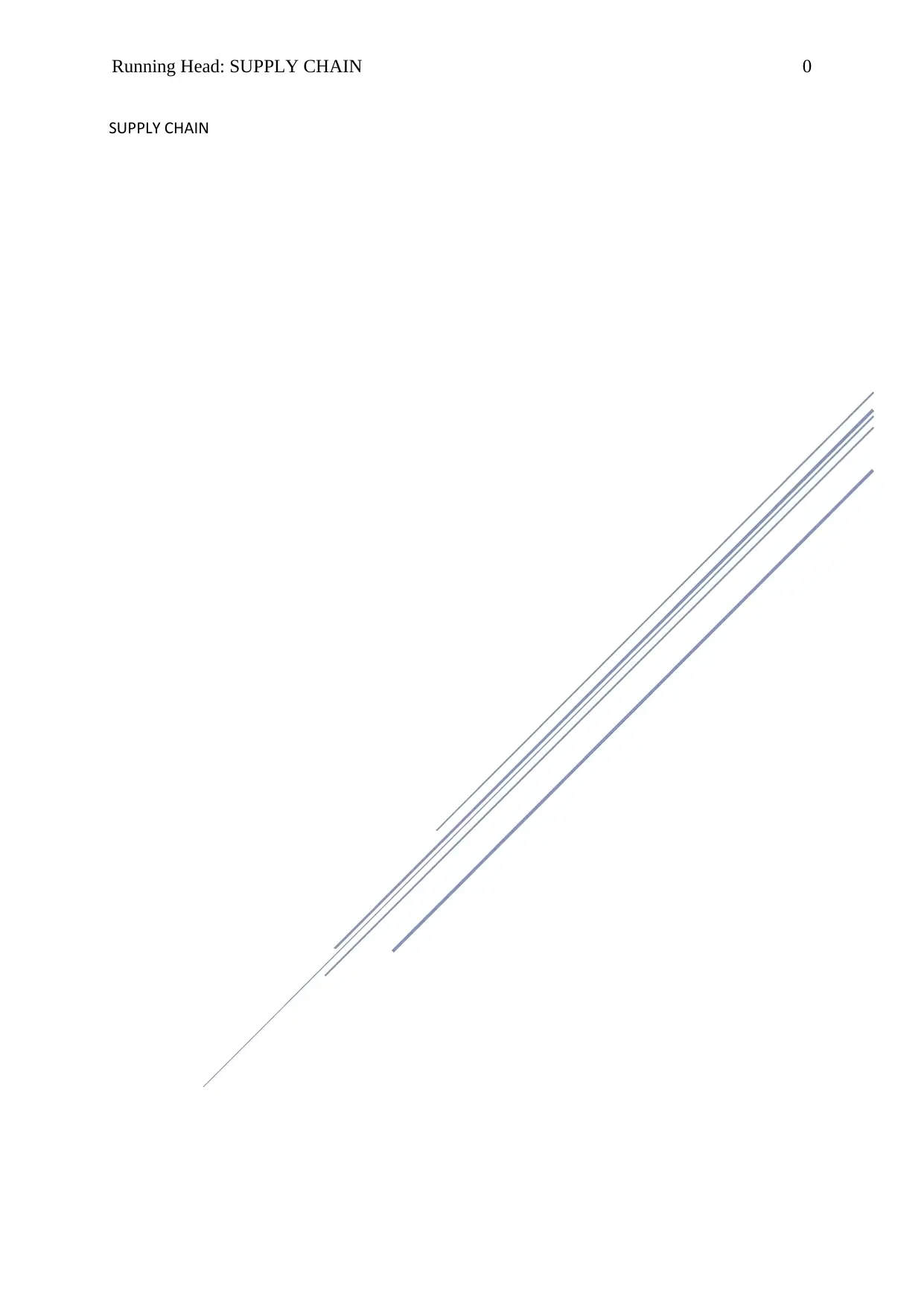
Running Head: SUPPLY CHAIN 0
SUPPLY CHAIN
SUPPLY CHAIN
Paraphrase This Document
Need a fresh take? Get an instant paraphrase of this document with our AI Paraphraser
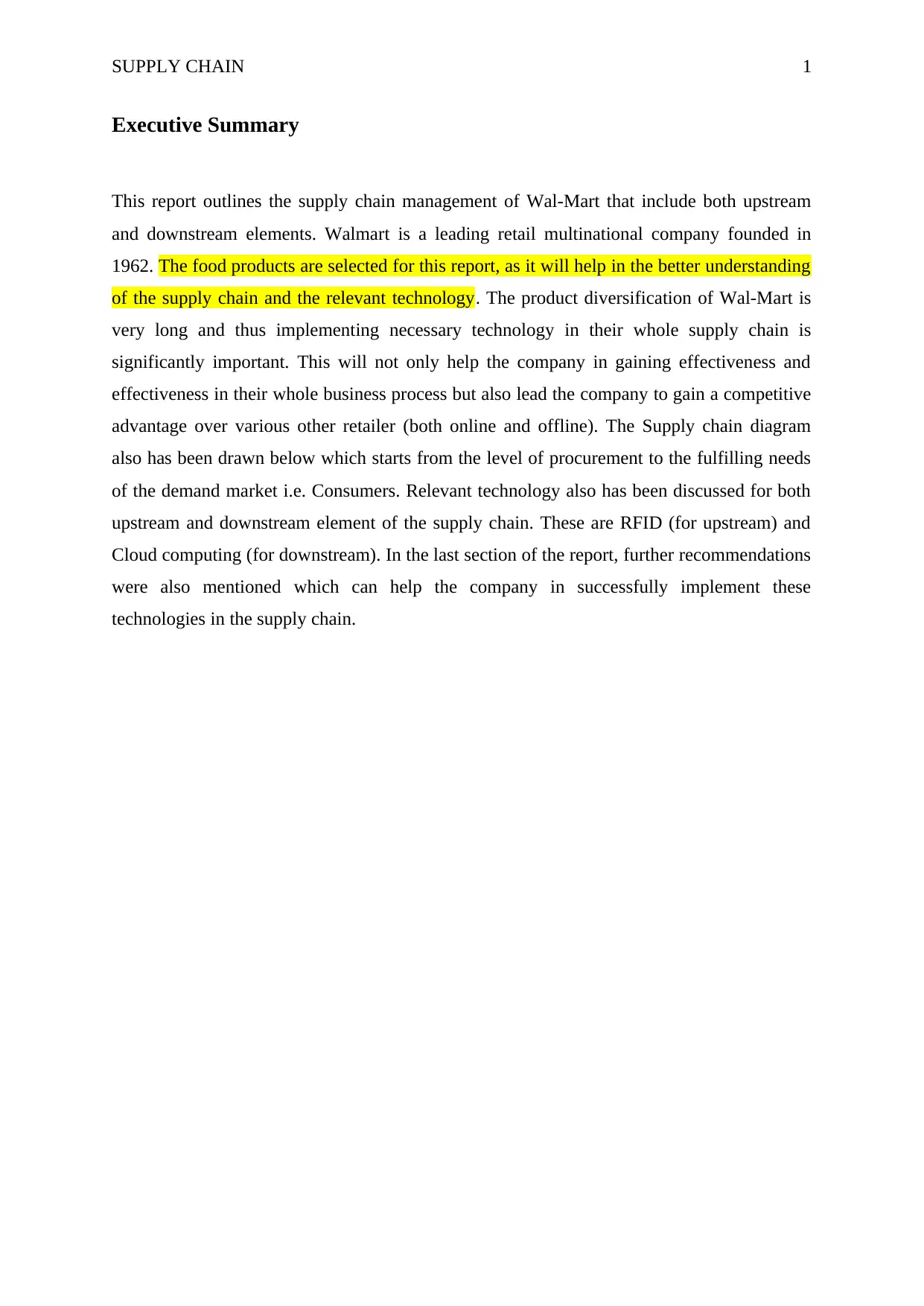
SUPPLY CHAIN 1
Executive Summary
This report outlines the supply chain management of Wal-Mart that include both upstream
and downstream elements. Walmart is a leading retail multinational company founded in
1962. The food products are selected for this report, as it will help in the better understanding
of the supply chain and the relevant technology. The product diversification of Wal-Mart is
very long and thus implementing necessary technology in their whole supply chain is
significantly important. This will not only help the company in gaining effectiveness and
effectiveness in their whole business process but also lead the company to gain a competitive
advantage over various other retailer (both online and offline). The Supply chain diagram
also has been drawn below which starts from the level of procurement to the fulfilling needs
of the demand market i.e. Consumers. Relevant technology also has been discussed for both
upstream and downstream element of the supply chain. These are RFID (for upstream) and
Cloud computing (for downstream). In the last section of the report, further recommendations
were also mentioned which can help the company in successfully implement these
technologies in the supply chain.
Executive Summary
This report outlines the supply chain management of Wal-Mart that include both upstream
and downstream elements. Walmart is a leading retail multinational company founded in
1962. The food products are selected for this report, as it will help in the better understanding
of the supply chain and the relevant technology. The product diversification of Wal-Mart is
very long and thus implementing necessary technology in their whole supply chain is
significantly important. This will not only help the company in gaining effectiveness and
effectiveness in their whole business process but also lead the company to gain a competitive
advantage over various other retailer (both online and offline). The Supply chain diagram
also has been drawn below which starts from the level of procurement to the fulfilling needs
of the demand market i.e. Consumers. Relevant technology also has been discussed for both
upstream and downstream element of the supply chain. These are RFID (for upstream) and
Cloud computing (for downstream). In the last section of the report, further recommendations
were also mentioned which can help the company in successfully implement these
technologies in the supply chain.
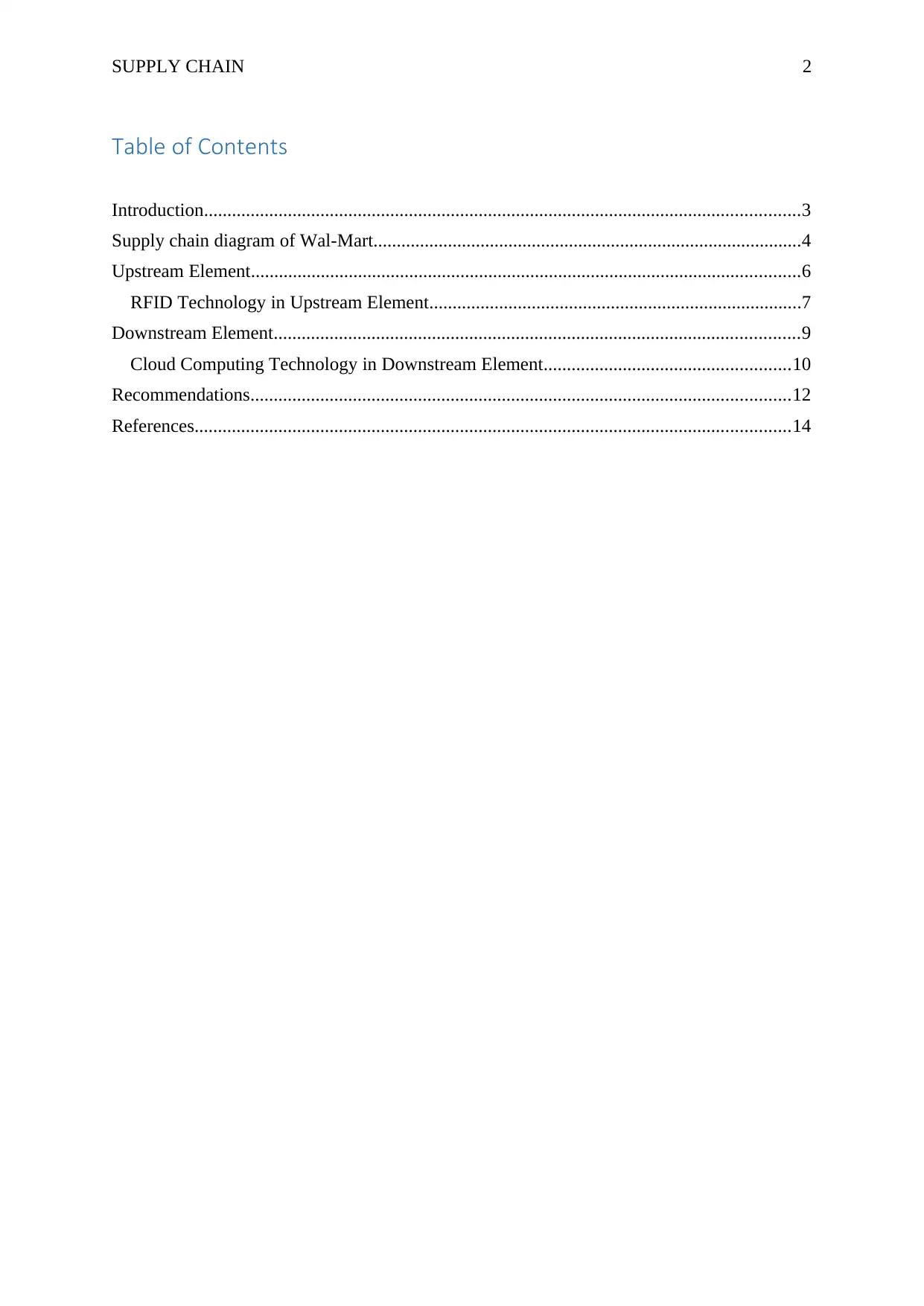
SUPPLY CHAIN 2
Table of Contents
Introduction................................................................................................................................3
Supply chain diagram of Wal-Mart............................................................................................4
Upstream Element......................................................................................................................6
RFID Technology in Upstream Element................................................................................7
Downstream Element.................................................................................................................9
Cloud Computing Technology in Downstream Element.....................................................10
Recommendations....................................................................................................................12
References................................................................................................................................14
Table of Contents
Introduction................................................................................................................................3
Supply chain diagram of Wal-Mart............................................................................................4
Upstream Element......................................................................................................................6
RFID Technology in Upstream Element................................................................................7
Downstream Element.................................................................................................................9
Cloud Computing Technology in Downstream Element.....................................................10
Recommendations....................................................................................................................12
References................................................................................................................................14
⊘ This is a preview!⊘
Do you want full access?
Subscribe today to unlock all pages.

Trusted by 1+ million students worldwide
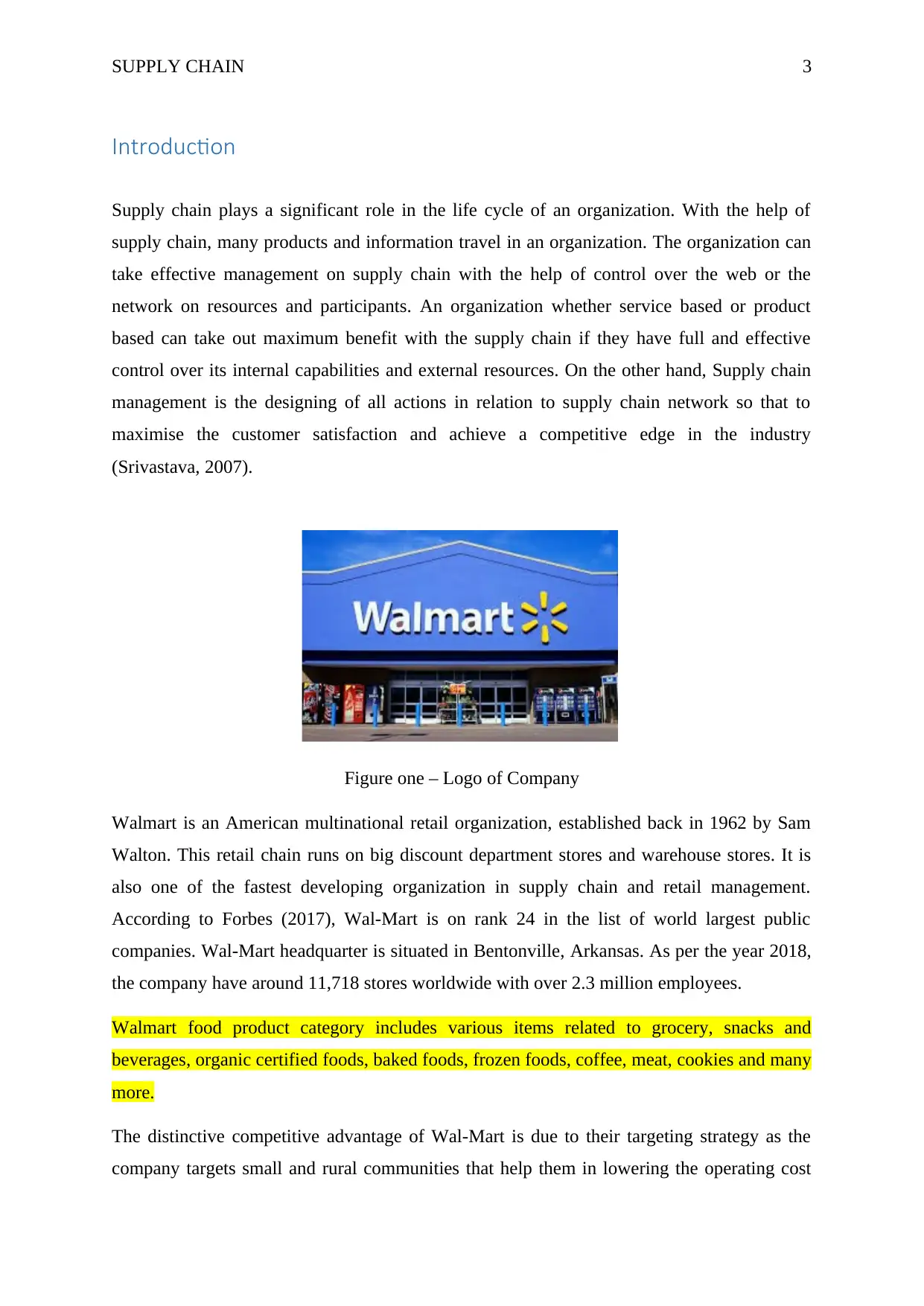
SUPPLY CHAIN 3
Introduction
Supply chain plays a significant role in the life cycle of an organization. With the help of
supply chain, many products and information travel in an organization. The organization can
take effective management on supply chain with the help of control over the web or the
network on resources and participants. An organization whether service based or product
based can take out maximum benefit with the supply chain if they have full and effective
control over its internal capabilities and external resources. On the other hand, Supply chain
management is the designing of all actions in relation to supply chain network so that to
maximise the customer satisfaction and achieve a competitive edge in the industry
(Srivastava, 2007).
Figure one – Logo of Company
Walmart is an American multinational retail organization, established back in 1962 by Sam
Walton. This retail chain runs on big discount department stores and warehouse stores. It is
also one of the fastest developing organization in supply chain and retail management.
According to Forbes (2017), Wal-Mart is on rank 24 in the list of world largest public
companies. Wal-Mart headquarter is situated in Bentonville, Arkansas. As per the year 2018,
the company have around 11,718 stores worldwide with over 2.3 million employees.
Walmart food product category includes various items related to grocery, snacks and
beverages, organic certified foods, baked foods, frozen foods, coffee, meat, cookies and many
more.
The distinctive competitive advantage of Wal-Mart is due to their targeting strategy as the
company targets small and rural communities that help them in lowering the operating cost
Introduction
Supply chain plays a significant role in the life cycle of an organization. With the help of
supply chain, many products and information travel in an organization. The organization can
take effective management on supply chain with the help of control over the web or the
network on resources and participants. An organization whether service based or product
based can take out maximum benefit with the supply chain if they have full and effective
control over its internal capabilities and external resources. On the other hand, Supply chain
management is the designing of all actions in relation to supply chain network so that to
maximise the customer satisfaction and achieve a competitive edge in the industry
(Srivastava, 2007).
Figure one – Logo of Company
Walmart is an American multinational retail organization, established back in 1962 by Sam
Walton. This retail chain runs on big discount department stores and warehouse stores. It is
also one of the fastest developing organization in supply chain and retail management.
According to Forbes (2017), Wal-Mart is on rank 24 in the list of world largest public
companies. Wal-Mart headquarter is situated in Bentonville, Arkansas. As per the year 2018,
the company have around 11,718 stores worldwide with over 2.3 million employees.
Walmart food product category includes various items related to grocery, snacks and
beverages, organic certified foods, baked foods, frozen foods, coffee, meat, cookies and many
more.
The distinctive competitive advantage of Wal-Mart is due to their targeting strategy as the
company targets small and rural communities that help them in lowering the operating cost
Paraphrase This Document
Need a fresh take? Get an instant paraphrase of this document with our AI Paraphraser
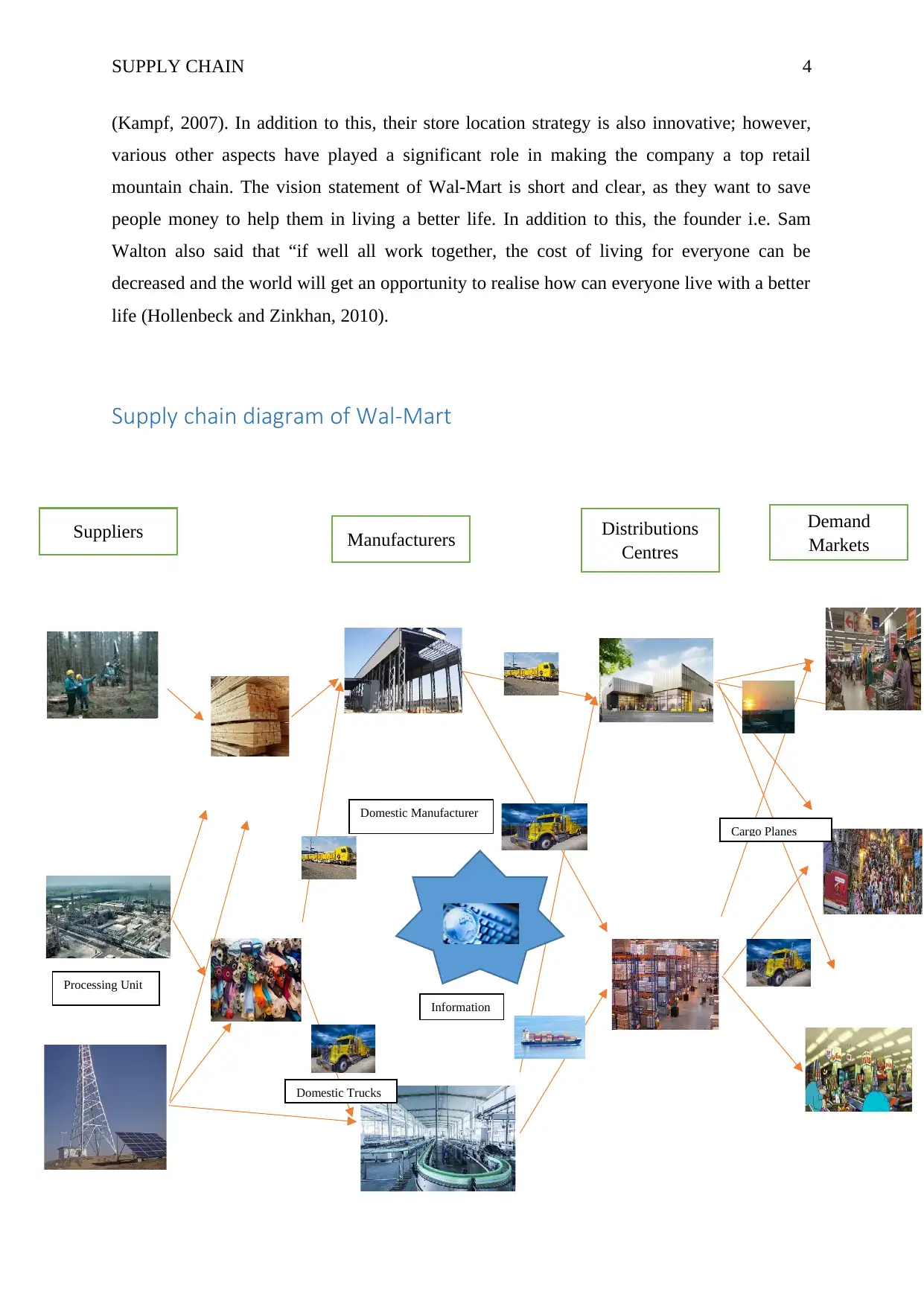
SUPPLY CHAIN 4
(Kampf, 2007). In addition to this, their store location strategy is also innovative; however,
various other aspects have played a significant role in making the company a top retail
mountain chain. The vision statement of Wal-Mart is short and clear, as they want to save
people money to help them in living a better life. In addition to this, the founder i.e. Sam
Walton also said that “if well all work together, the cost of living for everyone can be
decreased and the world will get an opportunity to realise how can everyone live with a better
life (Hollenbeck and Zinkhan, 2010).
Supply chain diagram of Wal-Mart
Suppliers Manufacturers Distributions
Centres
Demand
Markets
Domestic Manufacturer
Information
Domestic Trucks
Processing Unit
Cargo Planes
(Kampf, 2007). In addition to this, their store location strategy is also innovative; however,
various other aspects have played a significant role in making the company a top retail
mountain chain. The vision statement of Wal-Mart is short and clear, as they want to save
people money to help them in living a better life. In addition to this, the founder i.e. Sam
Walton also said that “if well all work together, the cost of living for everyone can be
decreased and the world will get an opportunity to realise how can everyone live with a better
life (Hollenbeck and Zinkhan, 2010).
Supply chain diagram of Wal-Mart
Suppliers Manufacturers Distributions
Centres
Demand
Markets
Domestic Manufacturer
Information
Domestic Trucks
Processing Unit
Cargo Planes
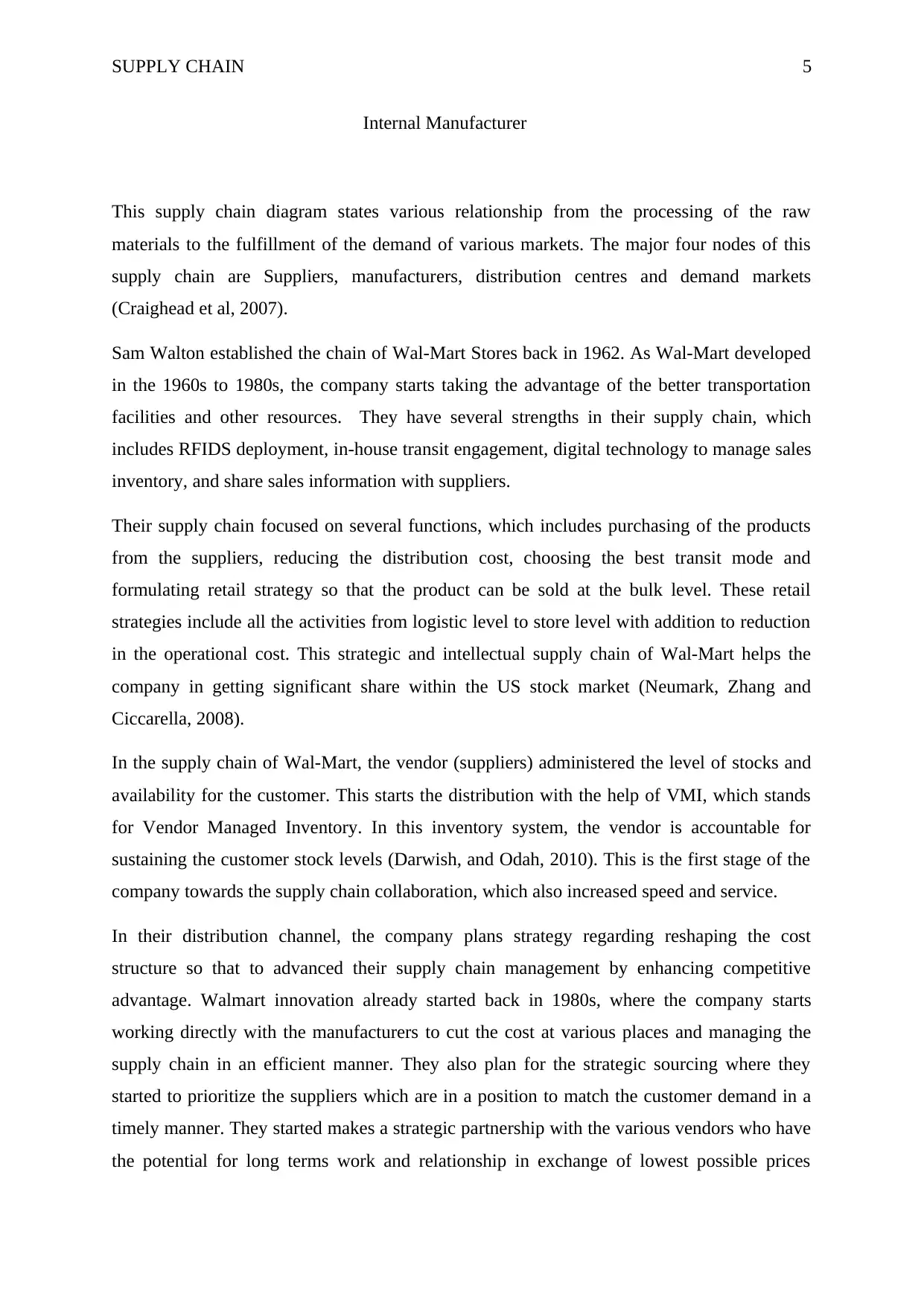
SUPPLY CHAIN 5
Internal Manufacturer
This supply chain diagram states various relationship from the processing of the raw
materials to the fulfillment of the demand of various markets. The major four nodes of this
supply chain are Suppliers, manufacturers, distribution centres and demand markets
(Craighead et al, 2007).
Sam Walton established the chain of Wal-Mart Stores back in 1962. As Wal-Mart developed
in the 1960s to 1980s, the company starts taking the advantage of the better transportation
facilities and other resources. They have several strengths in their supply chain, which
includes RFIDS deployment, in-house transit engagement, digital technology to manage sales
inventory, and share sales information with suppliers.
Their supply chain focused on several functions, which includes purchasing of the products
from the suppliers, reducing the distribution cost, choosing the best transit mode and
formulating retail strategy so that the product can be sold at the bulk level. These retail
strategies include all the activities from logistic level to store level with addition to reduction
in the operational cost. This strategic and intellectual supply chain of Wal-Mart helps the
company in getting significant share within the US stock market (Neumark, Zhang and
Ciccarella, 2008).
In the supply chain of Wal-Mart, the vendor (suppliers) administered the level of stocks and
availability for the customer. This starts the distribution with the help of VMI, which stands
for Vendor Managed Inventory. In this inventory system, the vendor is accountable for
sustaining the customer stock levels (Darwish, and Odah, 2010). This is the first stage of the
company towards the supply chain collaboration, which also increased speed and service.
In their distribution channel, the company plans strategy regarding reshaping the cost
structure so that to advanced their supply chain management by enhancing competitive
advantage. Walmart innovation already started back in 1980s, where the company starts
working directly with the manufacturers to cut the cost at various places and managing the
supply chain in an efficient manner. They also plan for the strategic sourcing where they
started to prioritize the suppliers which are in a position to match the customer demand in a
timely manner. They started makes a strategic partnership with the various vendors who have
the potential for long terms work and relationship in exchange of lowest possible prices
Internal Manufacturer
This supply chain diagram states various relationship from the processing of the raw
materials to the fulfillment of the demand of various markets. The major four nodes of this
supply chain are Suppliers, manufacturers, distribution centres and demand markets
(Craighead et al, 2007).
Sam Walton established the chain of Wal-Mart Stores back in 1962. As Wal-Mart developed
in the 1960s to 1980s, the company starts taking the advantage of the better transportation
facilities and other resources. They have several strengths in their supply chain, which
includes RFIDS deployment, in-house transit engagement, digital technology to manage sales
inventory, and share sales information with suppliers.
Their supply chain focused on several functions, which includes purchasing of the products
from the suppliers, reducing the distribution cost, choosing the best transit mode and
formulating retail strategy so that the product can be sold at the bulk level. These retail
strategies include all the activities from logistic level to store level with addition to reduction
in the operational cost. This strategic and intellectual supply chain of Wal-Mart helps the
company in getting significant share within the US stock market (Neumark, Zhang and
Ciccarella, 2008).
In the supply chain of Wal-Mart, the vendor (suppliers) administered the level of stocks and
availability for the customer. This starts the distribution with the help of VMI, which stands
for Vendor Managed Inventory. In this inventory system, the vendor is accountable for
sustaining the customer stock levels (Darwish, and Odah, 2010). This is the first stage of the
company towards the supply chain collaboration, which also increased speed and service.
In their distribution channel, the company plans strategy regarding reshaping the cost
structure so that to advanced their supply chain management by enhancing competitive
advantage. Walmart innovation already started back in 1980s, where the company starts
working directly with the manufacturers to cut the cost at various places and managing the
supply chain in an efficient manner. They also plan for the strategic sourcing where they
started to prioritize the suppliers which are in a position to match the customer demand in a
timely manner. They started makes a strategic partnership with the various vendors who have
the potential for long terms work and relationship in exchange of lowest possible prices
⊘ This is a preview!⊘
Do you want full access?
Subscribe today to unlock all pages.

Trusted by 1+ million students worldwide
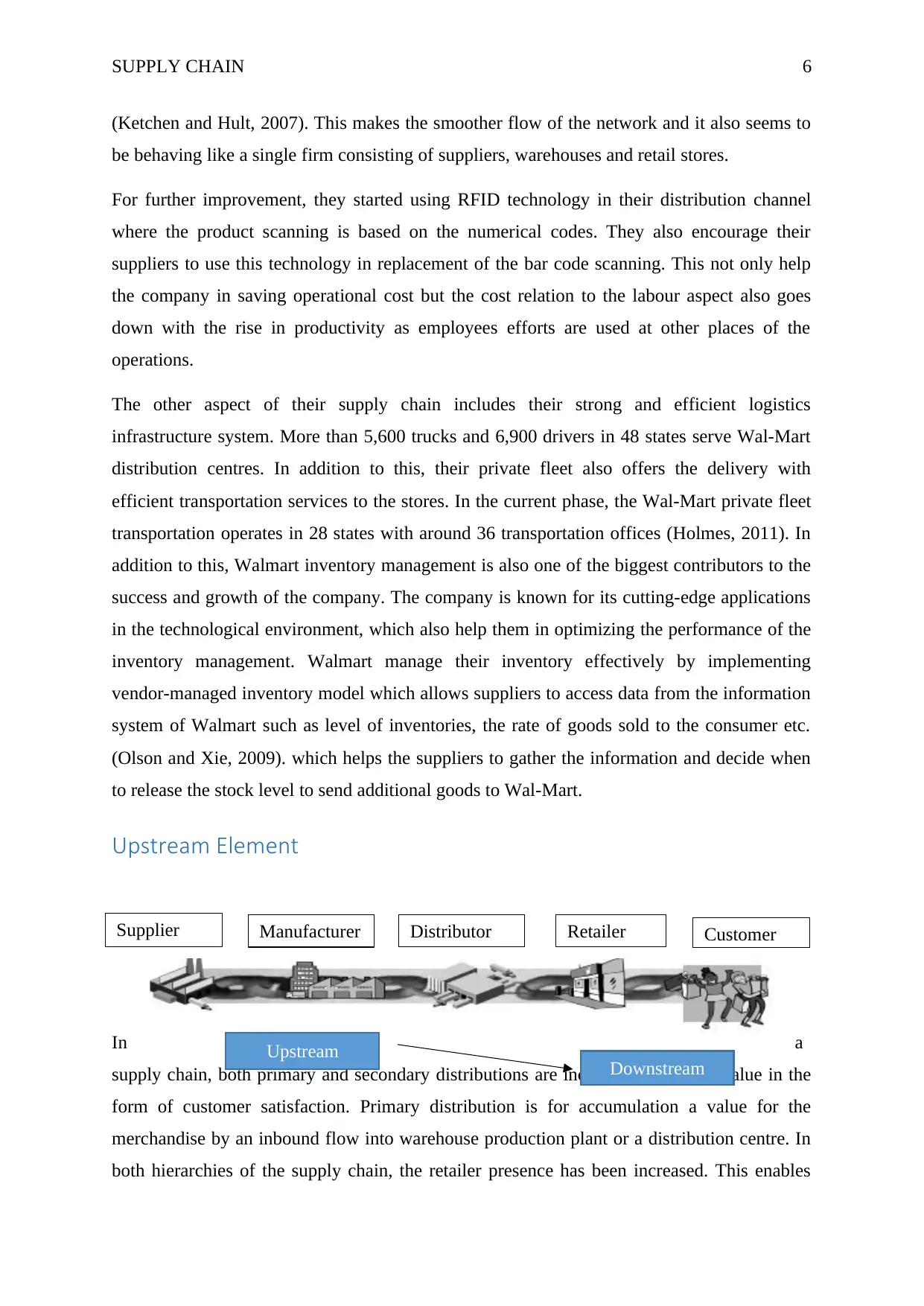
SUPPLY CHAIN 6
(Ketchen and Hult, 2007). This makes the smoother flow of the network and it also seems to
be behaving like a single firm consisting of suppliers, warehouses and retail stores.
For further improvement, they started using RFID technology in their distribution channel
where the product scanning is based on the numerical codes. They also encourage their
suppliers to use this technology in replacement of the bar code scanning. This not only help
the company in saving operational cost but the cost relation to the labour aspect also goes
down with the rise in productivity as employees efforts are used at other places of the
operations.
The other aspect of their supply chain includes their strong and efficient logistics
infrastructure system. More than 5,600 trucks and 6,900 drivers in 48 states serve Wal-Mart
distribution centres. In addition to this, their private fleet also offers the delivery with
efficient transportation services to the stores. In the current phase, the Wal-Mart private fleet
transportation operates in 28 states with around 36 transportation offices (Holmes, 2011). In
addition to this, Walmart inventory management is also one of the biggest contributors to the
success and growth of the company. The company is known for its cutting-edge applications
in the technological environment, which also help them in optimizing the performance of the
inventory management. Walmart manage their inventory effectively by implementing
vendor-managed inventory model which allows suppliers to access data from the information
system of Walmart such as level of inventories, the rate of goods sold to the consumer etc.
(Olson and Xie, 2009). which helps the suppliers to gather the information and decide when
to release the stock level to send additional goods to Wal-Mart.
Upstream Element
In a
supply chain, both primary and secondary distributions are included, which add value in the
form of customer satisfaction. Primary distribution is for accumulation a value for the
merchandise by an inbound flow into warehouse production plant or a distribution centre. In
both hierarchies of the supply chain, the retailer presence has been increased. This enables
Supplier CustomerManufacturer Distributor Retailer
Upstream Downstream
(Ketchen and Hult, 2007). This makes the smoother flow of the network and it also seems to
be behaving like a single firm consisting of suppliers, warehouses and retail stores.
For further improvement, they started using RFID technology in their distribution channel
where the product scanning is based on the numerical codes. They also encourage their
suppliers to use this technology in replacement of the bar code scanning. This not only help
the company in saving operational cost but the cost relation to the labour aspect also goes
down with the rise in productivity as employees efforts are used at other places of the
operations.
The other aspect of their supply chain includes their strong and efficient logistics
infrastructure system. More than 5,600 trucks and 6,900 drivers in 48 states serve Wal-Mart
distribution centres. In addition to this, their private fleet also offers the delivery with
efficient transportation services to the stores. In the current phase, the Wal-Mart private fleet
transportation operates in 28 states with around 36 transportation offices (Holmes, 2011). In
addition to this, Walmart inventory management is also one of the biggest contributors to the
success and growth of the company. The company is known for its cutting-edge applications
in the technological environment, which also help them in optimizing the performance of the
inventory management. Walmart manage their inventory effectively by implementing
vendor-managed inventory model which allows suppliers to access data from the information
system of Walmart such as level of inventories, the rate of goods sold to the consumer etc.
(Olson and Xie, 2009). which helps the suppliers to gather the information and decide when
to release the stock level to send additional goods to Wal-Mart.
Upstream Element
In a
supply chain, both primary and secondary distributions are included, which add value in the
form of customer satisfaction. Primary distribution is for accumulation a value for the
merchandise by an inbound flow into warehouse production plant or a distribution centre. In
both hierarchies of the supply chain, the retailer presence has been increased. This enables
Supplier CustomerManufacturer Distributor Retailer
Upstream Downstream
Paraphrase This Document
Need a fresh take? Get an instant paraphrase of this document with our AI Paraphraser
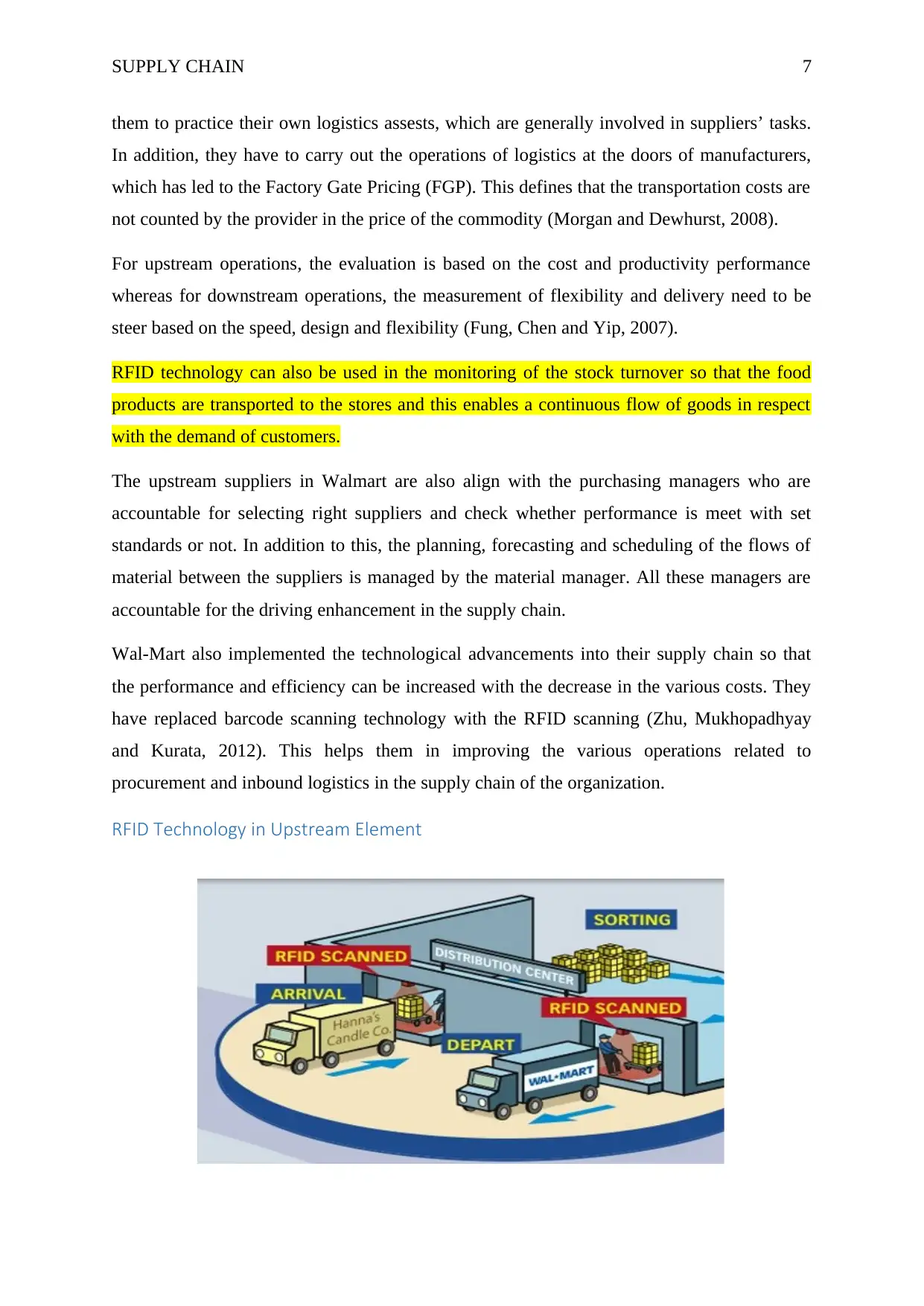
SUPPLY CHAIN 7
them to practice their own logistics assests, which are generally involved in suppliers’ tasks.
In addition, they have to carry out the operations of logistics at the doors of manufacturers,
which has led to the Factory Gate Pricing (FGP). This defines that the transportation costs are
not counted by the provider in the price of the commodity (Morgan and Dewhurst, 2008).
For upstream operations, the evaluation is based on the cost and productivity performance
whereas for downstream operations, the measurement of flexibility and delivery need to be
steer based on the speed, design and flexibility (Fung, Chen and Yip, 2007).
RFID technology can also be used in the monitoring of the stock turnover so that the food
products are transported to the stores and this enables a continuous flow of goods in respect
with the demand of customers.
The upstream suppliers in Walmart are also align with the purchasing managers who are
accountable for selecting right suppliers and check whether performance is meet with set
standards or not. In addition to this, the planning, forecasting and scheduling of the flows of
material between the suppliers is managed by the material manager. All these managers are
accountable for the driving enhancement in the supply chain.
Wal-Mart also implemented the technological advancements into their supply chain so that
the performance and efficiency can be increased with the decrease in the various costs. They
have replaced barcode scanning technology with the RFID scanning (Zhu, Mukhopadhyay
and Kurata, 2012). This helps them in improving the various operations related to
procurement and inbound logistics in the supply chain of the organization.
RFID Technology in Upstream Element
them to practice their own logistics assests, which are generally involved in suppliers’ tasks.
In addition, they have to carry out the operations of logistics at the doors of manufacturers,
which has led to the Factory Gate Pricing (FGP). This defines that the transportation costs are
not counted by the provider in the price of the commodity (Morgan and Dewhurst, 2008).
For upstream operations, the evaluation is based on the cost and productivity performance
whereas for downstream operations, the measurement of flexibility and delivery need to be
steer based on the speed, design and flexibility (Fung, Chen and Yip, 2007).
RFID technology can also be used in the monitoring of the stock turnover so that the food
products are transported to the stores and this enables a continuous flow of goods in respect
with the demand of customers.
The upstream suppliers in Walmart are also align with the purchasing managers who are
accountable for selecting right suppliers and check whether performance is meet with set
standards or not. In addition to this, the planning, forecasting and scheduling of the flows of
material between the suppliers is managed by the material manager. All these managers are
accountable for the driving enhancement in the supply chain.
Wal-Mart also implemented the technological advancements into their supply chain so that
the performance and efficiency can be increased with the decrease in the various costs. They
have replaced barcode scanning technology with the RFID scanning (Zhu, Mukhopadhyay
and Kurata, 2012). This helps them in improving the various operations related to
procurement and inbound logistics in the supply chain of the organization.
RFID Technology in Upstream Element
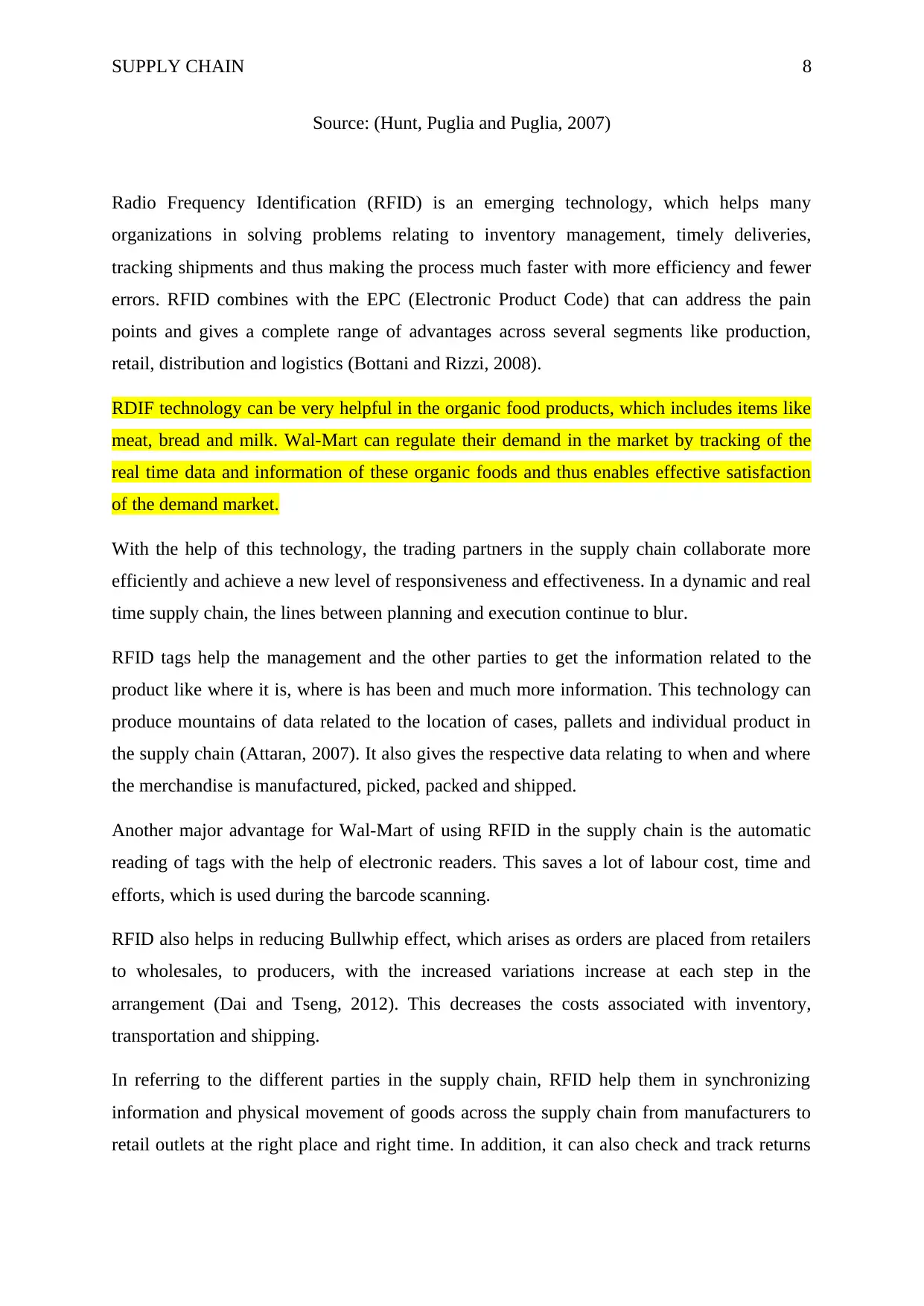
SUPPLY CHAIN 8
Source: (Hunt, Puglia and Puglia, 2007)
Radio Frequency Identification (RFID) is an emerging technology, which helps many
organizations in solving problems relating to inventory management, timely deliveries,
tracking shipments and thus making the process much faster with more efficiency and fewer
errors. RFID combines with the EPC (Electronic Product Code) that can address the pain
points and gives a complete range of advantages across several segments like production,
retail, distribution and logistics (Bottani and Rizzi, 2008).
RDIF technology can be very helpful in the organic food products, which includes items like
meat, bread and milk. Wal-Mart can regulate their demand in the market by tracking of the
real time data and information of these organic foods and thus enables effective satisfaction
of the demand market.
With the help of this technology, the trading partners in the supply chain collaborate more
efficiently and achieve a new level of responsiveness and effectiveness. In a dynamic and real
time supply chain, the lines between planning and execution continue to blur.
RFID tags help the management and the other parties to get the information related to the
product like where it is, where is has been and much more information. This technology can
produce mountains of data related to the location of cases, pallets and individual product in
the supply chain (Attaran, 2007). It also gives the respective data relating to when and where
the merchandise is manufactured, picked, packed and shipped.
Another major advantage for Wal-Mart of using RFID in the supply chain is the automatic
reading of tags with the help of electronic readers. This saves a lot of labour cost, time and
efforts, which is used during the barcode scanning.
RFID also helps in reducing Bullwhip effect, which arises as orders are placed from retailers
to wholesales, to producers, with the increased variations increase at each step in the
arrangement (Dai and Tseng, 2012). This decreases the costs associated with inventory,
transportation and shipping.
In referring to the different parties in the supply chain, RFID help them in synchronizing
information and physical movement of goods across the supply chain from manufacturers to
retail outlets at the right place and right time. In addition, it can also check and track returns
Source: (Hunt, Puglia and Puglia, 2007)
Radio Frequency Identification (RFID) is an emerging technology, which helps many
organizations in solving problems relating to inventory management, timely deliveries,
tracking shipments and thus making the process much faster with more efficiency and fewer
errors. RFID combines with the EPC (Electronic Product Code) that can address the pain
points and gives a complete range of advantages across several segments like production,
retail, distribution and logistics (Bottani and Rizzi, 2008).
RDIF technology can be very helpful in the organic food products, which includes items like
meat, bread and milk. Wal-Mart can regulate their demand in the market by tracking of the
real time data and information of these organic foods and thus enables effective satisfaction
of the demand market.
With the help of this technology, the trading partners in the supply chain collaborate more
efficiently and achieve a new level of responsiveness and effectiveness. In a dynamic and real
time supply chain, the lines between planning and execution continue to blur.
RFID tags help the management and the other parties to get the information related to the
product like where it is, where is has been and much more information. This technology can
produce mountains of data related to the location of cases, pallets and individual product in
the supply chain (Attaran, 2007). It also gives the respective data relating to when and where
the merchandise is manufactured, picked, packed and shipped.
Another major advantage for Wal-Mart of using RFID in the supply chain is the automatic
reading of tags with the help of electronic readers. This saves a lot of labour cost, time and
efforts, which is used during the barcode scanning.
RFID also helps in reducing Bullwhip effect, which arises as orders are placed from retailers
to wholesales, to producers, with the increased variations increase at each step in the
arrangement (Dai and Tseng, 2012). This decreases the costs associated with inventory,
transportation and shipping.
In referring to the different parties in the supply chain, RFID help them in synchronizing
information and physical movement of goods across the supply chain from manufacturers to
retail outlets at the right place and right time. In addition, it can also check and track returns
⊘ This is a preview!⊘
Do you want full access?
Subscribe today to unlock all pages.

Trusted by 1+ million students worldwide
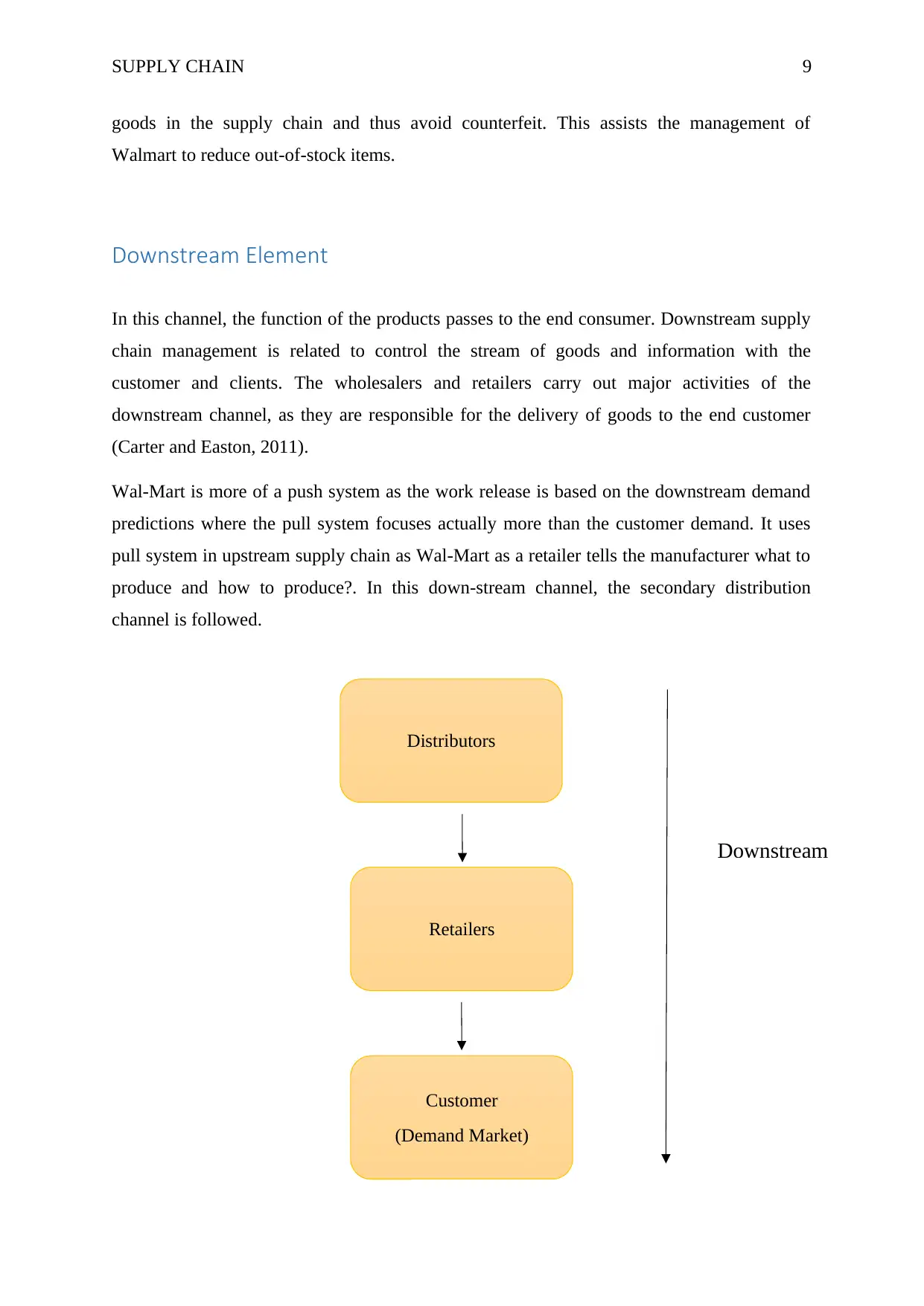
SUPPLY CHAIN 9
goods in the supply chain and thus avoid counterfeit. This assists the management of
Walmart to reduce out-of-stock items.
Downstream Element
In this channel, the function of the products passes to the end consumer. Downstream supply
chain management is related to control the stream of goods and information with the
customer and clients. The wholesalers and retailers carry out major activities of the
downstream channel, as they are responsible for the delivery of goods to the end customer
(Carter and Easton, 2011).
Wal-Mart is more of a push system as the work release is based on the downstream demand
predictions where the pull system focuses actually more than the customer demand. It uses
pull system in upstream supply chain as Wal-Mart as a retailer tells the manufacturer what to
produce and how to produce?. In this down-stream channel, the secondary distribution
channel is followed.
Distributors
Retailers
Customer
(Demand Market)
Downstream
goods in the supply chain and thus avoid counterfeit. This assists the management of
Walmart to reduce out-of-stock items.
Downstream Element
In this channel, the function of the products passes to the end consumer. Downstream supply
chain management is related to control the stream of goods and information with the
customer and clients. The wholesalers and retailers carry out major activities of the
downstream channel, as they are responsible for the delivery of goods to the end customer
(Carter and Easton, 2011).
Wal-Mart is more of a push system as the work release is based on the downstream demand
predictions where the pull system focuses actually more than the customer demand. It uses
pull system in upstream supply chain as Wal-Mart as a retailer tells the manufacturer what to
produce and how to produce?. In this down-stream channel, the secondary distribution
channel is followed.
Distributors
Retailers
Customer
(Demand Market)
Downstream
Paraphrase This Document
Need a fresh take? Get an instant paraphrase of this document with our AI Paraphraser
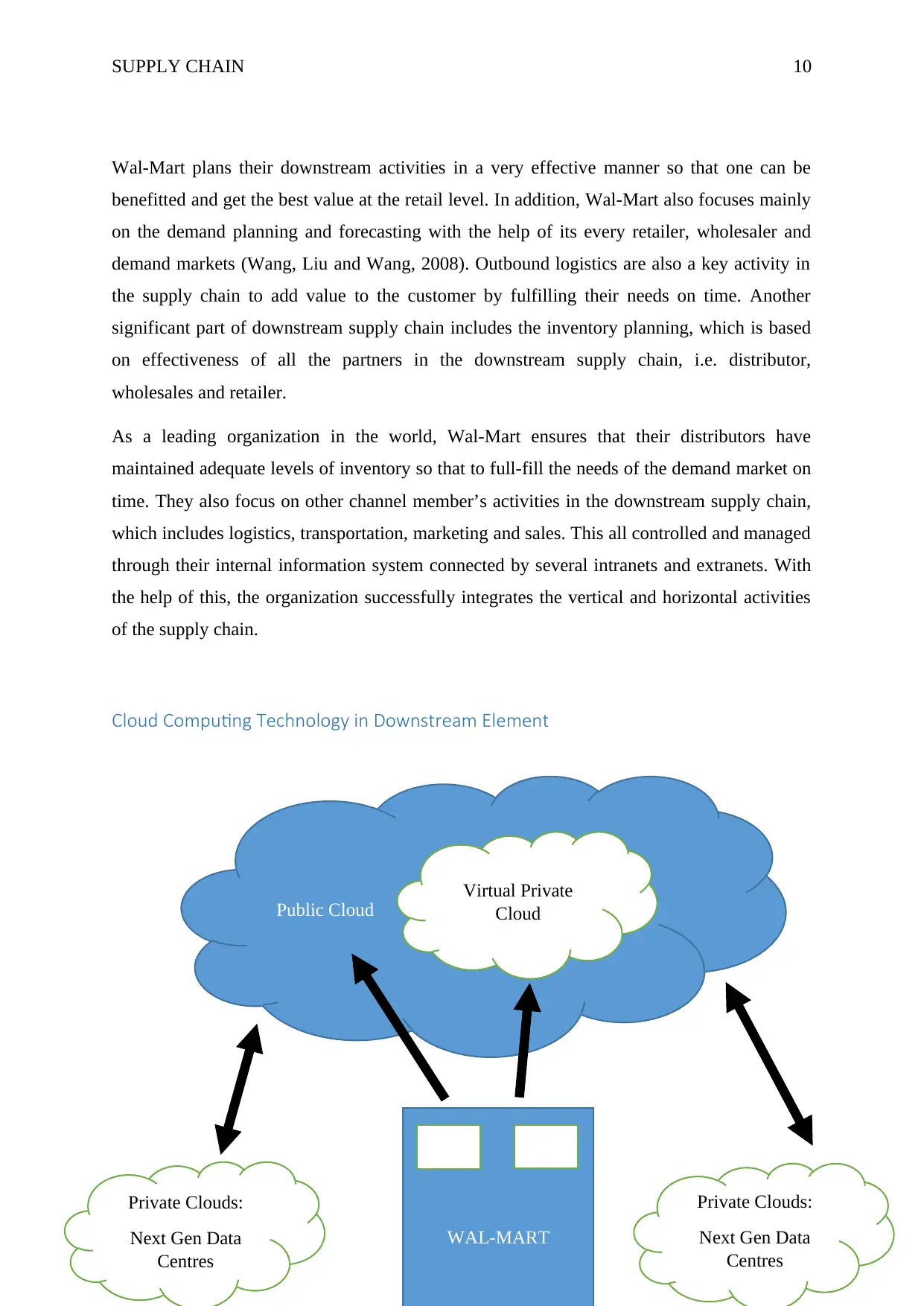
SUPPLY CHAIN 10
Wal-Mart plans their downstream activities in a very effective manner so that one can be
benefitted and get the best value at the retail level. In addition, Wal-Mart also focuses mainly
on the demand planning and forecasting with the help of its every retailer, wholesaler and
demand markets (Wang, Liu and Wang, 2008). Outbound logistics are also a key activity in
the supply chain to add value to the customer by fulfilling their needs on time. Another
significant part of downstream supply chain includes the inventory planning, which is based
on effectiveness of all the partners in the downstream supply chain, i.e. distributor,
wholesales and retailer.
As a leading organization in the world, Wal-Mart ensures that their distributors have
maintained adequate levels of inventory so that to full-fill the needs of the demand market on
time. They also focus on other channel member’s activities in the downstream supply chain,
which includes logistics, transportation, marketing and sales. This all controlled and managed
through their internal information system connected by several intranets and extranets. With
the help of this, the organization successfully integrates the vertical and horizontal activities
of the supply chain.
Cloud Computing Technology in Downstream Element
Public Cloud
Virtual Private
Cloud
WAL-MART
Private Clouds:
Next Gen Data
Centres
Private Clouds:
Next Gen Data
Centres
Wal-Mart plans their downstream activities in a very effective manner so that one can be
benefitted and get the best value at the retail level. In addition, Wal-Mart also focuses mainly
on the demand planning and forecasting with the help of its every retailer, wholesaler and
demand markets (Wang, Liu and Wang, 2008). Outbound logistics are also a key activity in
the supply chain to add value to the customer by fulfilling their needs on time. Another
significant part of downstream supply chain includes the inventory planning, which is based
on effectiveness of all the partners in the downstream supply chain, i.e. distributor,
wholesales and retailer.
As a leading organization in the world, Wal-Mart ensures that their distributors have
maintained adequate levels of inventory so that to full-fill the needs of the demand market on
time. They also focus on other channel member’s activities in the downstream supply chain,
which includes logistics, transportation, marketing and sales. This all controlled and managed
through their internal information system connected by several intranets and extranets. With
the help of this, the organization successfully integrates the vertical and horizontal activities
of the supply chain.
Cloud Computing Technology in Downstream Element
Public Cloud
Virtual Private
Cloud
WAL-MART
Private Clouds:
Next Gen Data
Centres
Private Clouds:
Next Gen Data
Centres
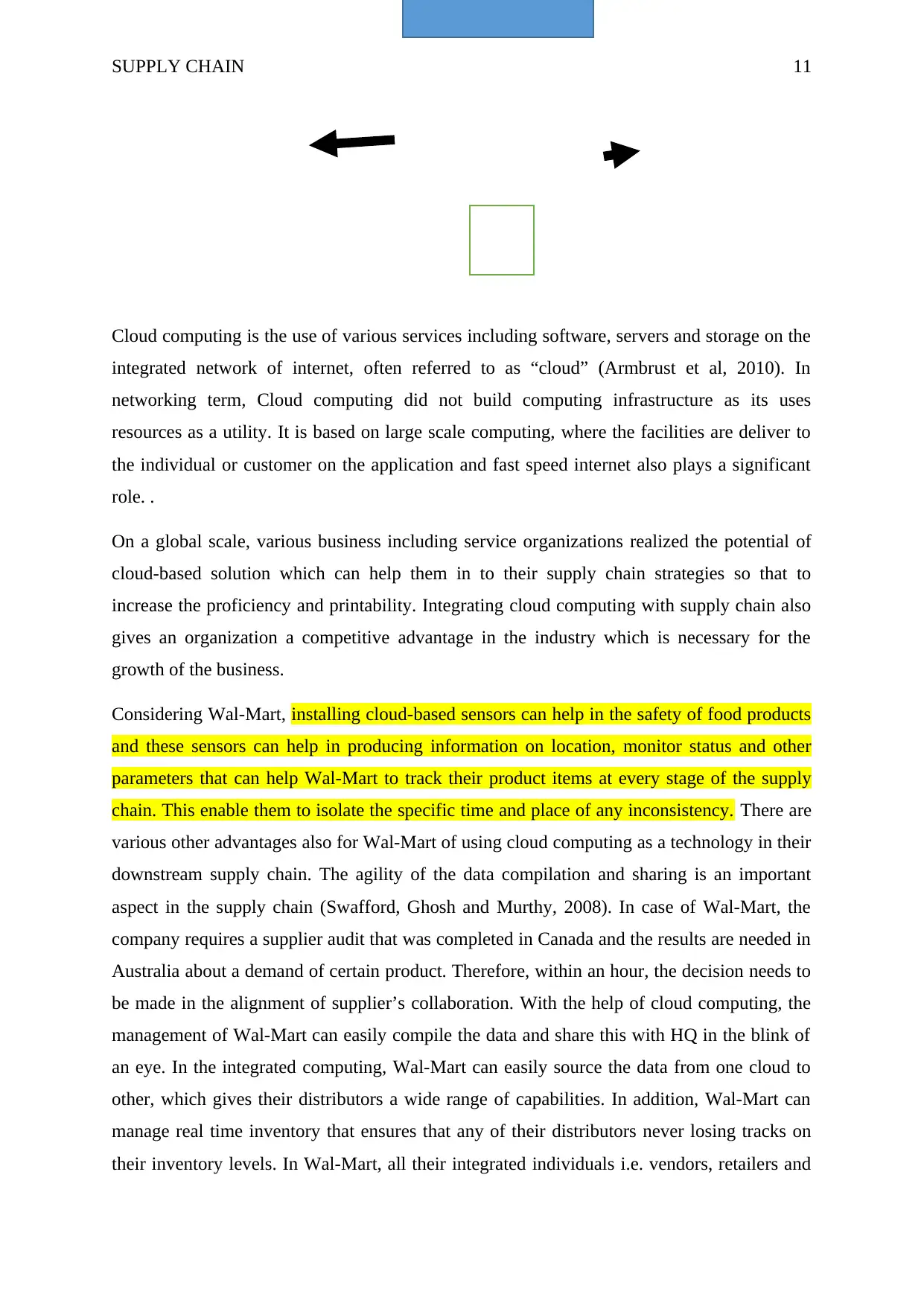
SUPPLY CHAIN 11
Cloud computing is the use of various services including software, servers and storage on the
integrated network of internet, often referred to as “cloud” (Armbrust et al, 2010). In
networking term, Cloud computing did not build computing infrastructure as its uses
resources as a utility. It is based on large scale computing, where the facilities are deliver to
the individual or customer on the application and fast speed internet also plays a significant
role. .
On a global scale, various business including service organizations realized the potential of
cloud-based solution which can help them in to their supply chain strategies so that to
increase the proficiency and printability. Integrating cloud computing with supply chain also
gives an organization a competitive advantage in the industry which is necessary for the
growth of the business.
Considering Wal-Mart, installing cloud-based sensors can help in the safety of food products
and these sensors can help in producing information on location, monitor status and other
parameters that can help Wal-Mart to track their product items at every stage of the supply
chain. This enable them to isolate the specific time and place of any inconsistency. There are
various other advantages also for Wal-Mart of using cloud computing as a technology in their
downstream supply chain. The agility of the data compilation and sharing is an important
aspect in the supply chain (Swafford, Ghosh and Murthy, 2008). In case of Wal-Mart, the
company requires a supplier audit that was completed in Canada and the results are needed in
Australia about a demand of certain product. Therefore, within an hour, the decision needs to
be made in the alignment of supplier’s collaboration. With the help of cloud computing, the
management of Wal-Mart can easily compile the data and share this with HQ in the blink of
an eye. In the integrated computing, Wal-Mart can easily source the data from one cloud to
other, which gives their distributors a wide range of capabilities. In addition, Wal-Mart can
manage real time inventory that ensures that any of their distributors never losing tracks on
their inventory levels. In Wal-Mart, all their integrated individuals i.e. vendors, retailers and
Cloud computing is the use of various services including software, servers and storage on the
integrated network of internet, often referred to as “cloud” (Armbrust et al, 2010). In
networking term, Cloud computing did not build computing infrastructure as its uses
resources as a utility. It is based on large scale computing, where the facilities are deliver to
the individual or customer on the application and fast speed internet also plays a significant
role. .
On a global scale, various business including service organizations realized the potential of
cloud-based solution which can help them in to their supply chain strategies so that to
increase the proficiency and printability. Integrating cloud computing with supply chain also
gives an organization a competitive advantage in the industry which is necessary for the
growth of the business.
Considering Wal-Mart, installing cloud-based sensors can help in the safety of food products
and these sensors can help in producing information on location, monitor status and other
parameters that can help Wal-Mart to track their product items at every stage of the supply
chain. This enable them to isolate the specific time and place of any inconsistency. There are
various other advantages also for Wal-Mart of using cloud computing as a technology in their
downstream supply chain. The agility of the data compilation and sharing is an important
aspect in the supply chain (Swafford, Ghosh and Murthy, 2008). In case of Wal-Mart, the
company requires a supplier audit that was completed in Canada and the results are needed in
Australia about a demand of certain product. Therefore, within an hour, the decision needs to
be made in the alignment of supplier’s collaboration. With the help of cloud computing, the
management of Wal-Mart can easily compile the data and share this with HQ in the blink of
an eye. In the integrated computing, Wal-Mart can easily source the data from one cloud to
other, which gives their distributors a wide range of capabilities. In addition, Wal-Mart can
manage real time inventory that ensures that any of their distributors never losing tracks on
their inventory levels. In Wal-Mart, all their integrated individuals i.e. vendors, retailers and
⊘ This is a preview!⊘
Do you want full access?
Subscribe today to unlock all pages.

Trusted by 1+ million students worldwide
1 out of 18
Related Documents
Your All-in-One AI-Powered Toolkit for Academic Success.
+13062052269
info@desklib.com
Available 24*7 on WhatsApp / Email
![[object Object]](/_next/static/media/star-bottom.7253800d.svg)
Unlock your academic potential
Copyright © 2020–2025 A2Z Services. All Rights Reserved. Developed and managed by ZUCOL.





